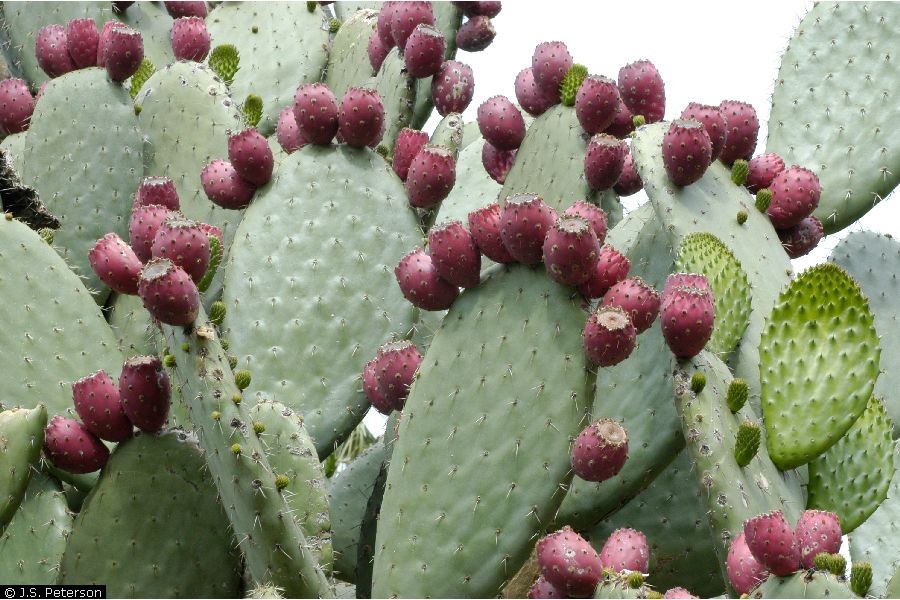NOPAL CACTUS

Nopal Cactus also known as ―Prickly Pear‖, ―Indian Fig‖, ―Cactus Tuna‖, or “Barbary Fig”
Scientifically called Opuntia Spp. For over 12,000 years, fresh Nopal cactus has been consumed for its legendary qualities. Cultivated around the world, Nopal cactus is generally believed to be indigenous to North America, particularly Mexico. Considered to be a valuable food source in Mexico, and an integral part of their culture, that it appears on their national flag. Natural News states that Nopal cactus has been a staple part of Mexican and Mexican-American cuisine for centuries. The green pads of the Nopal cactus are cooked and added to tacos, egg dishes, and Mexican salads. Research within the past ten years has caused Nopal cactus to be considered a super-food, due to its antioxidant and cholesterol-reducing properties.
The fruit of the prickly pear is rich in betalains. Several clinical studies suggest Nopal cactus is beneficial for diabetics because it reduces blood glucose levels. According to Reuters, some 10,000 farmers cultivate Nopal in Mexico, producing around $150 million worth of it each year. Only recently, in the last 20 years, has modern science truly been interested in the investigation of its nutritional and medicinal properties. The interest in this prickly plant is due to both the medical research and the wonderful taste of the fruit. Prickly pear has been used in Mexico to treat diabetes for over 1,000 years and is one of the most utilized natural products in Central America. The use of prickly pear as a natural helper in the treatment of diabetes is well known among native cultures. It is known to have hypoglycemic effects. It has been reported as beneficial to a whole host of conditions. Research has shown its beneficial actions on the cardiovascular system by decreasing platelet activity. This means it is good for both the heart and blood vessels.
The cactus pads of the prickly pear contain essential vitamins and minerals such as potassium, magnesium, calcium, iron, vitamin A, in the form of beta-carotene and vitamin C. Nopal Cactus is the only plant to contain 24 of the known betalains, which are potent anti-inflammatory agents. Betalains are polyphenolic pigments found in beets. Betalains give Nopal cactus their purple-red and yellow colors. Prickly pear juice power comes from its ability to fight chronic inflammation. The pads of prickly pear fruit contain a wide range of amino acids. This includes the 8 essential amino acids, which our bodies don‘t produce. Nopal cactus is a plant that provides more essential amino acids than most other sources. The mucilage found inside the sticky pads of the stem contain polysaccharides, which are found in immune system stimulating plants.
- Fiber
Nopal cactus has a high level of both soluble and insoluble fiber (also known as roughage), which helps maintain a healthy digestive tract. Thanks to heavy processing and chemical recombination, fiber is missing in much of the modern Western diet, and the lack of fiber (especially roughage) has been linked to many illnesses including diabetes and colon cancer. Taking in high fiber promotes regular bowel movements, and taking in insoluble fiber, can help to better regulate the body’s metabolism, staving off illnesses like hyperglycemia and diabetes.
- Polysaccharide Fibers
- Antioxidants
Like many vegetables, the Nopal cactus is high in antioxidants. These vitamins and flavonoids work to reduce the stress put on the body by toxic chemicals and free radicals. Especially helpful in the liver, antioxidants work to neutralize all the pre-processing and toxicity in most diets. These chemicals can also help the body deal with highly toxic situations like hangovers and drug detoxification. Although not able to provide full relief from the aftereffects of extreme alcohol or drug abuse, the Nopal cactus has often been used as a palliative when treating a hangover or used as a pad for those looking to clean their system of prescription or illegal drugs. In humans, these rare antioxidants serve a very specific purpose within the cells- they capture and “diffuse” free radicals (unstable molecules) before they have a chance to destroy or damage anything. Free radical damage to the cells is what causes the aging process, which is why Nopal cactus juice is said to have anti-aging properties.
- Anti-Cancer Agent
Cactus juice may help reduce risk for cancer, says Da-mingZou, lead author for a study published in Nutrition Journal. It may someday be used as a natural alternative to chemoprevention of cancer, in which chemical agents are used to ward off cancer among high-risk populations. Chemical agents are expensive and have numerous undesirable side effects. Cactus juice may be a good alternative because it can inhibit cancer cell growth and slow tumor growth, says Zou. Cactus works just as well as a synthetic retinoid that’s being used in chemoprevention trials, Zou says, but he notes that more study is needed to confirm this benefit and the mechanism by which the cactus works.
- Inflammation fighting capabilities
Chronic inflammation is the result of the body’s inability to control its own immune response. What starts out as a normal call for help to your white blood cells because you bumped your knee or twisted your ankle, causes a cascade effect which results in your body not being able to “flick the off switch” on the call for help. A number of ethanol extract studies on the Nopal fruit have shown that ingestion of it can inhibit leukocyte (white blood cell) migration, which is the catalyst in the development of inflammatory disease. In addition, the studies showed suppression of edema, or fluid retention.
- Lowering Bad Cholesterol
- Decrease of Blood Sugar Values
- Cholesterol
- Diabetes
- Side Effects
- Drug Interactions
